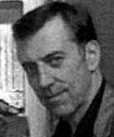

Doug Michels, an architect and artist and a founding member of Ant Farm, died on June 12 at Eden Bay in Australia. He was 59 and lived in Houston, Texas.
In August 1968, Doug Michels arrived in San Francisco driving a 1967 lime green Cadillac convertible with his wife, Carol, a design student named Doug Hurr, and a German shepherd puppy named Cheyenne. The “drive-away”car had to be turned in the next day, but that night we toured counter-cultural San Francisco in style.
Founded in San Francisco, Ant Farm was named in recognition of our statement that we were “underground architects,” ready to restructure the built environment of the counter culture. When few commissions turned up, we moved to Houston in 1969 to teach at the University of Houston College of Architecture. A student revolt had thrown out the dean, and students demanded that the school hire the guy who had come through on a lecture tour the year before— Doug Michels. Ant Farm was launched in Houston and produced architectural happenings and media events—Astro Daze, Time Slice, Plastic Businessman, Enviroman, the Electronic Oasis, and Avenue to Infinity. These were architectural songs for a concept album, honed by jamming in the studio and performed live on occasion.
Recognition came in the form of an invitation to the Paris Biennial, and we sent the Electronic Oasis, a time capsule in the form of a cardboard box containing postcards and souvenirs of cowtown Texas and the July 1969 Moon landing. Doug went to Paris and, with his traveling companion, did an unannounced performance titled Make Love Not War under an American flag on the steps of the Musee de Arte Moderne.
When the U of H didn’t renew our teaching contracts, we went back to California and set up a studio on Gate 5 Road in Sausalito to design and build inflatable structures. Then, in 1971, Marilyn Oshman commissioned us to design a weekend house on a lake outside Houston. This modest $25,000 job grew into a year and a half design/build experiment in hand-made futurism. Doug and I moved back to Texas and, working with Richard Jost, a Houston architect/builder, designed the House of the Century, named by the client’s husband, Alvin Lubetkin, who paid the bills. It won a Progressive Architecture Design Citation in 1973. Doug and Richard shaved their heads for the PA photo session—I was the token long hair.
The Texas-California dialectic remained throughout Ant Farm’s decade and resulted in the Cadillac Ranch, designed in our studio at Pier 40 in San Francisco in early 1974 and constructed outside Amarillo in June. The project was commissioned by Stanley Marsh III of Amarillo, a millionaire whose local TV station was famous for the fast cars he bought the newsmen. Doug and I worked with Ant Farm partner Hudson Marquez, with whom we shared the experience of growing up in the “Auto-America” of the 1950s, a time when the Cadillac as status symbol was something to aspire to, and the Cadillac slogan, “Standard of the World,” was really true.
Building the Cadillac Ranch was relatively easy—it just took four days and a back-hoe to plant the ten different models, so on the fifth day we had a party, wore rented tuxedos, and drank ourselves silly with Stanley and Wendy Marsh’s friends. June 21, 2004, will mark the 30th anniversary of Cadillac Ranch, and it will be celebrated with a party at the site, as were the 10th and 20th anniversaries. But this past June 21, the Cadillac Ranch was painted black in memory of Doug—flat black was his favorite color.
The Berkeley Art Museum will exhibit Ant Farm 1968 – 1978 beginning 14 January 2004 and running to April 26. The exhibition will then go to The Santa Monica Museum of Art (July 2 – August 29, 2004); the ICA, Philadelphia; the Blaffer gallery at the University of Houston; and the Center for Media Art, Karlsruhe, Germany.
Author Chip Lord, co-founder of Ant Farm, is chair of the Film and Digital Media Department at UC Santa Cruz.
Originally published 3rd quarter 2003, in arcCA 03.3, “Done Good.”





